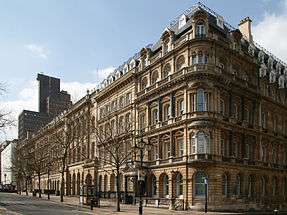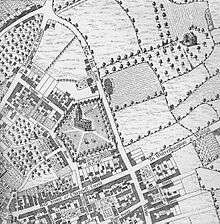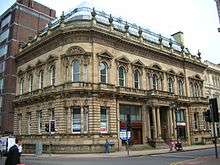Colmore Row
Colmore Row is a street in Birmingham City Centre in the centre of Birmingham, England, running from Victoria Square to just beyond Snow Hill station. It is traditionally the city's most prestigious business address.[2]
 55 Colmore Row | |
| Former name(s) | New Hall Lane |
|---|---|
| Length | 0.3 mi[1] (0.5 km) |
| Postal code | B3 |
| northeast end | Colmore Circus 52.4827°N 1.8972°W |
| southwest end | Victoria Square 52.48025°N 1.9021°W |
Colmore Row and its environs were designated a conservation area in 1971, which was extended twice in 1985. Colmore Row itself has 23 listed buildings, two listed at Grade I and two at Grade II*.[3]
History



Before this area of Birmingham was developed in the 18th century, Colmore Row was a country lane called New Hall Lane, connecting the roads from City centre to Dudley and West Bromwich and separating the farmlands of the New Hall Estate to the north from those of the Inge Estate to the south.[4] Development of the south of the lane started with the building of St Philip's Church (now St Philip's Cathedral) in 1708. In 1746, a private Act of Parliament opened up the New Hall Estate to the north for development, with the first plots being let and developed from 1747 onwards.[5]
The road was renamed at this point, but initially only the stretch between Newhall Street and Livery Street was named Colmore Row (after the Colmore family, owners of the New Hall Estate). The stretch between Newhall Street and New Street was named Ann Street, after head of the family Ann Colmore, while the stretch north of Livery Street, originally called Bull Lane, became known as Monmouth Street.[5]
Ann Street disappeared as a name when the street was divided between Colmore Row and Victoria Square, when the latter was created (initially as Council House Square) in 1879.
The original buildings of Colmore Row were the brick and stucco Georgian houses typical of the late 18th century. The 120 year leases on these properties started to expire in the 1840s and 1850s, and between 1869 and 1900 all were replaced by the late Victorian commercial premises that still give the street its predominant character.[6]

After the Second World War, Colmore Row was to have formed part of the extensive Inner Ring Road system planned by City Engineer Herbert Manzoni. This would have necessitated demolishing all of the buildings between Colmore Row and Waterloo Street, but fell victim to increasing land values and awareness of conservation issues in the 1970s. The plans for the street included widening it to a width of 112 ft (34 m) with a central reservation of 14 ft (4.3 m) in width.[7] Ironically, the likelihood of forthcoming comprehensive redevelopment protected many of the buildings from being demolished to make way for office developments (see Colmore Business District), and today Colmore Row and the surrounding area has one of the most consistent 19th century streetscapes in Central Birmingham.[4]
In the 1980s, Barclays proposed a redevelopment of 55-73 Colmore Row. The scheme involved the demolition of the entire building except for the façades and the banking hall of the listed building. The local planning authority called for greater retention of the building structure as with other schemes in the area. The agents submitted multiple planning applications to put pressure on the planning department. As the planning department failed to come to a decision on two planning applications in their time periods, the bank took the case to a government department. Barclays and local planning authority failed to reach any deal in negotiations, which eventually broke down. The government saw that the retention of the façade was satisfactory as it allowed the economic reuse of the site. The decision left the development and design framework for the area in a weakened state as the building subject to the decision was deemed to be of less national importance in respect to its local importance.[8] The use of façadism on the building has since been seen as successful following the addition of Mansard roofs providing additional floorspace.[9]
Transport Hub
In addition to Snow Hill station, Colmore Row also hosts the city centre bus stops AB to AF - which together have the IATA location identifier code ZBC.[10]
Notable buildings

This is a list of notable buildings on Colmore Row in order from west to east.
- 122-124 Colmore Row, former Eagle Insurance Company offices (William Lethaby and Joseph Ball, 1900 [11]
- 114-116 Colmore Row, former Atlas Assurance office (Paul Waterhouse, 1912)[12]
- 110 Colmore Row, former National Insurance Co. office (Henman & Cooper, 1903)[13]
- National Westminster House (John Madin, 1974) - now demolished.
- 85 Colmore Row, former Union Club (Yeoville Thomason, 1869)[14]
- St Philip's Cathedral (Thomas Archer, 1725)[15]
- Grand Hotel, (Thomson Plevins, 1875)
- Great Western Arcade (W. H. Ward, 1876)[16]
- Colmore Gate (Seymour Harris Partnership, 1992)
- Snow Hill railway station (Seymour Harris Partnership, 1987)
See also
| Wikimedia Commons has media related to Colmore Row, Birmingham. |
- List of conservation areas in the West Midlands
References
- "Driving directions to Colmore Row". Google. Retrieved 10 October 2013.
- "Birmingham Office Market Overview" (PDF). Reuters Real Estate. Archived from the original (PDF) on 15 July 2011. Retrieved 13 October 2007.
Birmingham has seen a number of significant changes in the last few years. Primarily, the structure of the Birmingham office market has seen an expansion and redefinition of its traditional prime office core. What was once centred round Colmore Row, Edmund Street and Newhall Street, over the last seven years the market has seen 850,000 sq ft (79,000 m2) of newly developed space at Brindleyplace and further space at The Mailbox. Additional schemes are also in the pipeline outside the traditional core, including Eastside and Paradise Circus.
- "Colmore Row and Environs Conservation Area". Birmingham City Council. Archived from the original on 17 September 2007. Retrieved 13 October 2007.
- Foster, Andy (2005). "Colmore Row". Birmingham. Pevsner Architectural Guides. London: Yale University Press. pp. 93–100. ISBN 0-300-10731-5.
- "Colmore Row and Environs Conservation Area - Character Appraisal and Supplementary Planning Policies". Archived from the original on 30 September 2007. Retrieved 13 October 2007.
- Foster, Andy (2005). "The Newhall Estate". Birmingham. Pevsner Architectural Guides. London: Yale University Press. pp. 129–140. ISBN 0-300-10731-5.
- Institution of Mechanical Engineers (1957). Proceedings. Institution of Mechanical Engineers.
- Philip Allmendinger; Huw Thomas (1998). Urban Planning and the British New Right. Routledge. pp. 78–79. ISBN 0-415-15463-4.
- Peter J. Larkham (1996). Conservation and the City. Routledge. p. 244. ISBN 0-415-07947-0.
- "Birmingham Colmore Row Bus Stn". theAirDB. Retrieved 3 May 2009.
- Historic England. "122 and 124 Colmore Row (1343375)". National Heritage List for England. Retrieved 23 April 2015.
- Historic England. "Standard House, 114 and 116 Colmore Row (1343414)". National Heritage List for England. Retrieved 23 April 2015.
- Historic England. "110 Colmore Row (1290581)". National Heritage List for England. Retrieved 23 April 2015.
- Historic England. "Union Club, Colmore Row (1210201)". National Heritage List for England. Retrieved 23 April 2015.
- Historic England. "Cathedral Church of St Philip (1076173)". National Heritage List for England. Retrieved 23 April 2015.
- Historic England. "Great Western Arcade (1211434)". National Heritage List for England. Retrieved 23 April 2015.